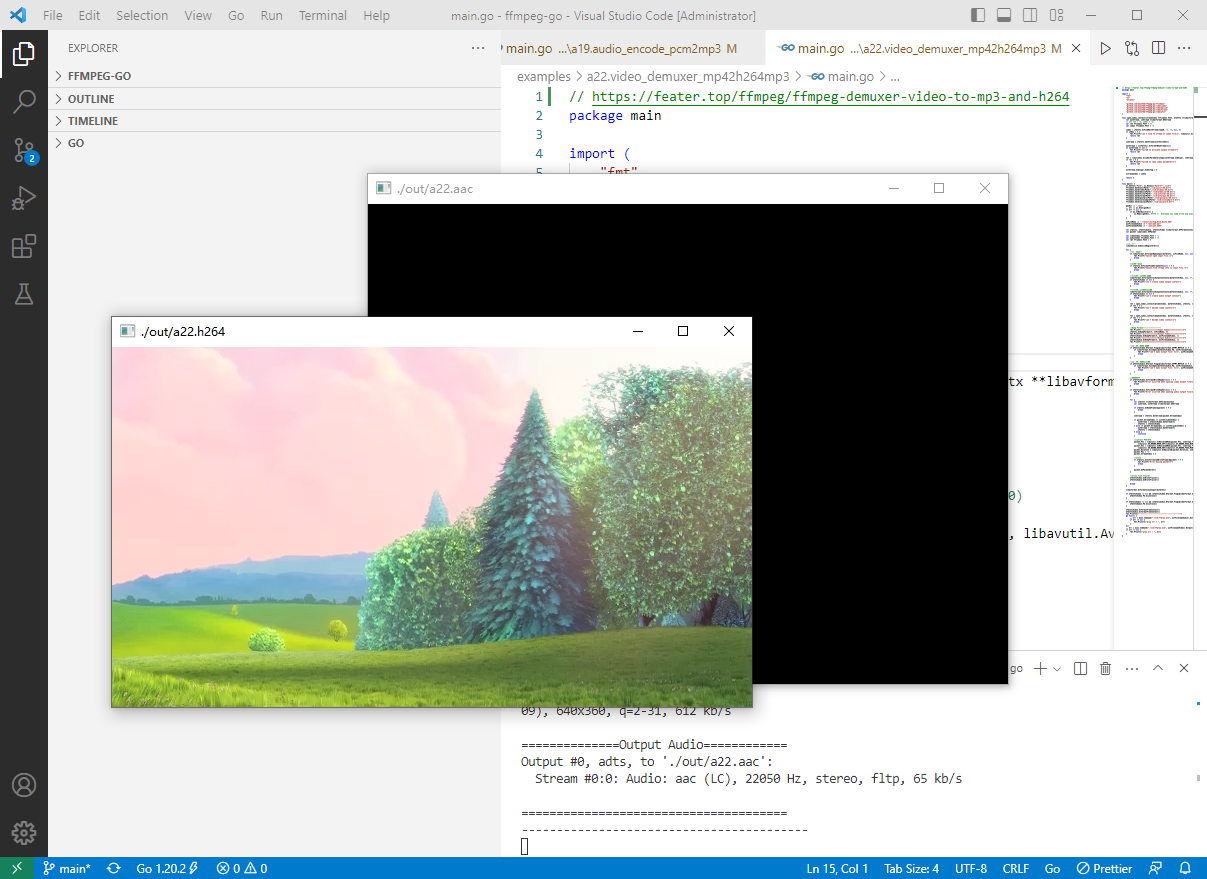2023-03-21:音视频解混合(demuxer)为MP3和H264,用go语言编写。
2023-03-21:音视频解混合(demuxer)为MP3和H264,用go语言编写。
答案2023-03-21:
步骤1:安装github.com/moonfdd/ffmpeg-go
go get -u github.com/moonfdd/ffmpeg-go
步骤2:导入所需的库
接下来,我们需要导入所需的库。这些库包括fmt、os、exec以及FFmpeg库中的libavcodec、libavdevice、libavformat和libavutil。在本教程中,我们还将使用moonfdd/ffmpeg-go库,该库提供了一些便捷的函数和类型定义,可帮助我们更轻松地使用FFmpeg库。
package main
import (
"fmt"
"os"
"os/exec"
"github.com/moonfdd/ffmpeg-go/ffcommon"
"github.com/moonfdd/ffmpeg-go/libavcodec"
"github.com/moonfdd/ffmpeg-go/libavdevice"
"github.com/moonfdd/ffmpeg-go/libavformat"
"github.com/moonfdd/ffmpeg-go/libavutil"
)
步骤3:设置FFmpeg库路径
在使用FFmpeg库之前,我们需要设置FFmpeg库的路径。您可以通过设置环境变量来实现这一点,也可以直接调用FFmpeg库的SetXxxPath函数进行设置。
// 设置环境变量
os.Setenv("Path", os.Getenv("Path")+";./lib")
// 设置FFmpeg库路径
ffcommon.SetAvutilPath("./lib/avutil-56.dll")
ffcommon.SetAvcodecPath("./lib/avcodec-58.dll")
ffcommon.SetAvdevicePath("./lib/avdevice-58.dll")
ffcommon.SetAvfilterPath("./lib/avfilter-56.dll")
ffcommon.SetAvformatPath("./lib/avformat-58.dll")
ffcommon.SetAvpostprocPath("./lib/postproc-55.dll")
ffcommon.SetAvswresamplePath("./lib/swresample-3.dll")
ffcommon.SetAvswscalePath("./lib/swscale-5.dll")
步骤4:定义必要的变量
在使用FFmpeg库之前,我们需要定义一些必要的变量。这些变量包括输入文件名、输出音频文件名、输出视频文件名、输入格式上下文、输出音频格式上下文、输出视频格式上下文、AVPacket等。在本教程中,我们还定义了用于保存视频索引和音频索引的变量。
var ifmtCtx, ofmtCtxAudio, ofmtCtxVideo *libavformat.AVFormatContext
var packet libavcodec.AVPacket
var videoIndex ffcommon.FInt = -1
var audioIndex ffcommon.FInt = -1
var ret ffcommon.FInt = 0
inFileName := "./resources/big_buck_bunny.mp4"
outFilenameAudio := "./out/a22.aac"
outFilenameVideo := "./out/a22.h264"
步骤5:注册设备
在使用FFmpeg库之前,我们需要先注册设备。您可以使用libavdevice.AvdeviceRegisterAll()函数来注册所有支持的设备。
libavdevice.AvdeviceRegisterAll()
步骤6:打开输入流
在从音视频文件中分离出音频和视频之前,我们需要打开音视频文件的输入流。您可以使用libavformat.AvformatOpenInput函数来打开输入流,并使用ifmtCtx参数保存输入流的上下文。
if libavformat.AvformatOpenInput(&ifmtCtx, inFileName, nil, nil) < 0 {
fmt.Printf("Could not open input file '%s'\n", inFileName)
return
}
defer ifmtCtx.AvformatCloseInput()
步骤7:读取媒体信息
打开输入流后,我们需要读取音视频文件的媒体信息。您可以使用libavformat.AvformatFindStreamInfo函数来读取媒体信息,并使用libavutil.AvDumpFormat函数将媒体信息输出到控制台。
if ifmtCtx.AvformatFindStreamInfo(nil) < 0 {
fmt.Println("Could not find stream information")
return
}
libavutil.AvDumpFormat(ifmtCtx, 0, inFileName, 0)
步骤8:查找音频和视频流
在读取媒体信息后,我们需要查找音频和视频流。您可以使用libavformat.AvformatFindStreamInfo函数来查找音频和视频流,并使用videoIndex和audioIndex变量保存视频流和音频流的索引。
for i := 0; i < int(ifmtCtx.NbStreams()); i++ {
codecParams := ifmtCtx.Streams()[i].CodecParameters()
codecType := codecParams.AvCodecGetType()
switch codecType {
case libavutil.AVMEDIA_TYPE_VIDEO:
if videoIndex == -1 {
videoIndex = ffcommon.FInt(i)
}
case libavutil.AVMEDIA_TYPE_AUDIO:
if audioIndex == -1 {
audioIndex = ffcommon.FInt(i)
}
}
}
if videoIndex == -1 || audioIndex == -1 {
fmt.Println("Could not find video or audio stream")
return
}
步骤9:打开输出流
在查找音频和视频流后,我们需要打开输出流,以便将分离出的音频和视频写入文件。您可以使用libavformat.AvformatAllocOutputContext2函数创建输出格式上下文,并使用ofmtCtxAudio和ofmtCtxVideo变量保存输出格式上下文。
// 打开输出音频流
if ofmtCtxAudio = libavformat.AvformatAllocOutputContext2(nil, nil, "", outFilenameAudio); ofmtCtxAudio == nil {
fmt.Printf("could not create output context for '%s'\n", outFilenameAudio)
return
}
// 打开输出视频流
if ofmtCtxVideo = libavformat.AvformatAllocOutputContext2(nil, nil, "h264", outFilenameVideo); ofmtCtxVideo == nil {
fmt.Printf("could not create output context for '%s'\n", outFilenameVideo)
return
}
步骤10:写入文件头
打开输出流后,我们需要写入文件头。您可以使用libavformat.AvformatWriteHeader函数来写入文件头。
// 写入音频文件头
if (ofmtCtxAudio.Oformat().Flags() & libavformat.AVFMT_NOFILE) == 0 {
if ret = ofmtCtxAudio.AvioOpen(nil, libavformat.AVIO_FLAG_WRITE); ret < 0 {
fmt.Printf("could not open output file '%s'\n", outFilenameAudio)
return
}
defer ofmtCtxAudio.AvioClose()
}
if ret = ofmtCtxAudio.AvformatWriteHeader(nil); ret < 0 {
fmt.Println("Could not write output file header")
return
}
// 写入视频文件头
if (ofmtCtxVideo.Oformat().Flags() & libavformat.AVFMT_NOFILE) == 0 {
if ret = ofmtCtxVideo.AvioOpen(nil, libavformat.AVIO_FLAG_WRITE); ret < 0 {
fmt.Printf("could not open output file '%s'\n", outFilenameVideo)
return
}
defer ofmtCtxVideo.AvioClose()
}
if ret = ofmtCtxVideo.AvformatWriteHeader(nil); ret < 0 {
fmt.Println("Could not write output file header")
return
}
步骤11:分离音频和视频
写入文件头后,我们可以开始分离音频和视频了。您可以使用libavformat.AvReadFrame函数读取音视频帧,并根据音频或视频流的索引将音频帧写入音频文件,将视频帧写入视频文件。
for {
if ret = ifmtCtx.AvReadFrame(&packet); ret <0 {
break
}
defer packet.AvPacketUnref()
if packet.StreamIndex() == audioIndex {
// 写入音频流
if ret = ofmtCtxAudio.AvInterleavedWriteFrame(&packet); ret < 0 {
fmt.Printf("error while writing audio frame: %v\n", ret)
return
}
} else if packet.StreamIndex() == videoIndex {
// 写入视频流
if ret = ofmtCtxVideo.AvInterleavedWriteFrame(&packet); ret < 0 {
fmt.Printf("error while writing video frame: %v\n", ret)
return
}
}
}
步骤12:写入文件尾
完成音视频分离后,我们需要写入文件尾。您可以使用libavformat.AvWriteTrailer函数来写入文件尾。
// 写入音频文件尾
if ret = ofmtCtxAudio.AvWriteTrailer(); ret < 0 {
fmt.Println("Could not write output file trailer")
return
}
// 写入视频文件尾
if ret = ofmtCtxVideo.AvWriteTrailer(); ret < 0 {
fmt.Println("Could not write output file trailer")
return
}
完整代码
// https://feater.top/ffmpeg/ffmpeg-demuxer-video-to-mp3-and-h264
package main
import (
"fmt"
"os"
"os/exec"
"github.com/moonfdd/ffmpeg-go/ffcommon"
"github.com/moonfdd/ffmpeg-go/libavcodec"
"github.com/moonfdd/ffmpeg-go/libavdevice"
"github.com/moonfdd/ffmpeg-go/libavformat"
"github.com/moonfdd/ffmpeg-go/libavutil"
)
func open_codec_context(streamIndex *ffcommon.FInt, ofmtCtx **libavformat.AVFormatContext, ifmtCtx *libavformat.AVFormatContext, type0 libavutil.AVMediaType) ffcommon.FInt {
var outStream, inStream *libavformat.AVStream
// int ret = -1, index = -1;
var ret ffcommon.FInt = -1
var index ffcommon.FInt = -1
index = ifmtCtx.AvFindBestStream(type0, -1, -1, nil, 0)
if index < 0 {
fmt.Printf("can't find %s stream in input file\n", libavutil.AvGetMediaTypeString(type0))
return ret
}
inStream = ifmtCtx.GetStream(uint32(index))
outStream = (*ofmtCtx).AvformatNewStream(nil)
if outStream == nil {
fmt.Printf("failed to allocate output stream\n")
return ret
}
ret = libavcodec.AvcodecParametersCopy(outStream.Codecpar, inStream.Codecpar)
if ret < 0 {
fmt.Printf("failed to copy codec parametes\n")
return ret
}
outStream.Codecpar.CodecTag = 0
*streamIndex = index
return 0
}
func main() {
os.Setenv("Path", os.Getenv("Path")+";./lib")
ffcommon.SetAvutilPath("./lib/avutil-56.dll")
ffcommon.SetAvcodecPath("./lib/avcodec-58.dll")
ffcommon.SetAvdevicePath("./lib/avdevice-58.dll")
ffcommon.SetAvfilterPath("./lib/avfilter-56.dll")
ffcommon.SetAvformatPath("./lib/avformat-58.dll")
ffcommon.SetAvpostprocPath("./lib/postproc-55.dll")
ffcommon.SetAvswresamplePath("./lib/swresample-3.dll")
ffcommon.SetAvswscalePath("./lib/swscale-5.dll")
genDir := "./out"
_, err := os.Stat(genDir)
if err != nil {
if os.IsNotExist(err) {
os.Mkdir(genDir, 0777) // Everyone can read write and execute
}
}
inFileName := "./resources/big_buck_bunny.mp4"
outFilenameAudio := "./out/a22.aac"
outFilenameVideo := "./out/a22.h264"
var ifmtCtx, ofmtCtxAudio, ofmtCtxVideo *libavformat.AVFormatContext
var packet libavcodec.AVPacket
var videoIndex ffcommon.FInt = -1
var audioIndex ffcommon.FInt = -1
var ret ffcommon.FInt = 0
//注册设备
libavdevice.AvdeviceRegisterAll()
for {
//打开输入流
if libavformat.AvformatOpenInput(&ifmtCtx, inFileName, nil, nil) < 0 {
fmt.Printf("Cannot open input file.\n")
break
}
//获取流信息
if ifmtCtx.AvformatFindStreamInfo(nil) < 0 {
fmt.Printf("Cannot find stream info in input file.\n")
break
}
//创建输出上下文:视频
libavformat.AvformatAllocOutputContext2(&ofmtCtxVideo, nil, "", outFilenameVideo)
if ofmtCtxVideo == nil {
fmt.Printf("can't create video output context")
break
}
//创建输出上下文:音频
libavformat.AvformatAllocOutputContext2(&ofmtCtxAudio, nil, "", outFilenameAudio)
if ofmtCtxAudio == nil {
fmt.Printf("can't create audio output context")
break
}
ret = open_codec_context(&videoIndex, &ofmtCtxVideo, ifmtCtx, libavutil.AVMEDIA_TYPE_VIDEO)
if ret < 0 {
fmt.Printf("can't decode video context\n")
break
}
ret = open_codec_context(&audioIndex, &ofmtCtxAudio, ifmtCtx, libavutil.AVMEDIA_TYPE_AUDIO)
if ret < 0 {
fmt.Printf("can't decode video context\n")
break
}
//Dump Format------------------
fmt.Printf("\n==============Input Video=============\n")
ifmtCtx.AvDumpFormat(0, inFileName, 0)
fmt.Printf("\n==============Output Video============\n")
ofmtCtxVideo.AvDumpFormat(0, outFilenameVideo, 1)
fmt.Printf("\n==============Output Audio============\n")
ofmtCtxAudio.AvDumpFormat(0, outFilenameAudio, 1)
fmt.Printf("\n======================================\n")
//打开输出文件:视频
if ofmtCtxVideo.Oformat.Flags&libavformat.AVFMT_NOFILE == 0 {
if libavformat.AvioOpen(&ofmtCtxVideo.Pb, outFilenameVideo, libavformat.AVIO_FLAG_WRITE) < 0 {
fmt.Printf("can't open output file: %s\n", outFilenameVideo)
break
}
}
//打开输出文件:音频
if ofmtCtxAudio.Oformat.Flags&libavformat.AVFMT_NOFILE == 0 {
if libavformat.AvioOpen(&ofmtCtxAudio.Pb, outFilenameAudio, libavformat.AVIO_FLAG_WRITE) < 0 {
fmt.Printf("can't open output file: %s\n", outFilenameVideo)
break
}
}
//写文件头
if ofmtCtxVideo.AvformatWriteHeader(nil) < 0 {
fmt.Printf("Error occurred when opening video output file\n")
break
}
if ofmtCtxAudio.AvformatWriteHeader(nil) < 0 {
fmt.Printf("Error occurred when opening audio output file\n")
break
}
for {
var ofmtCtx *libavformat.AVFormatContext
var inStream, outStream *libavformat.AVStream
if ifmtCtx.AvReadFrame(&packet) < 0 {
break
}
inStream = ifmtCtx.GetStream(packet.StreamIndex)
if packet.StreamIndex == uint32(videoIndex) {
outStream = ofmtCtxVideo.GetStream(0)
ofmtCtx = ofmtCtxVideo
} else if packet.StreamIndex == uint32(audioIndex) {
outStream = ofmtCtxAudio.GetStream(0)
ofmtCtx = ofmtCtxAudio
} else {
continue
}
//convert PTS/DTS
packet.Pts = libavutil.AvRescaleQRnd(packet.Pts, inStream.TimeBase, outStream.TimeBase,
libavutil.AV_ROUND_NEAR_INF|libavutil.AV_ROUND_PASS_MINMAX)
packet.Dts = libavutil.AvRescaleQRnd(packet.Dts, inStream.TimeBase, outStream.TimeBase,
libavutil.AV_ROUND_NEAR_INF|libavutil.AV_ROUND_PASS_MINMAX)
packet.Duration = libavutil.AvRescaleQ(packet.Duration, inStream.TimeBase, outStream.TimeBase)
packet.Pos = -1
packet.StreamIndex = 0
//write
if ofmtCtx.AvInterleavedWriteFrame(&packet) < 0 {
fmt.Printf("Error muxing packet\n")
break
}
packet.AvPacketUnref()
}
//write file trailer
ofmtCtxVideo.AvWriteTrailer()
ofmtCtxAudio.AvWriteTrailer()
break
}
libavformat.AvformatCloseInput(&ifmtCtx)
if ofmtCtxVideo != nil && (ofmtCtxVideo.Oformat.Flags&libavformat.AVFMT_NOFILE) == 0 {
ofmtCtxVideo.Pb.AvioClose()
}
if ofmtCtxAudio != nil && (ofmtCtxAudio.Oformat.Flags&libavformat.AVFMT_NOFILE) == 0 {
ofmtCtxAudio.Pb.AvioClose()
}
ofmtCtxVideo.AvformatFreeContext()
ofmtCtxAudio.AvformatFreeContext()
fmt.Println("-----------------------------------------")
go func() {
_, err = exec.Command("./lib/ffplay.exe", outFilenameAudio).Output()
if err != nil {
fmt.Println("play err = ", err)
}
}()
_, err = exec.Command("./lib/ffplay.exe", outFilenameVideo).Output()
if err != nil {
fmt.Println("play err = ", err)
}
}
执行结果
执行命令:
go run ./examples/a22.video_demuxer_mp42h264mp3/main.go






【推荐】国内首个AI IDE,深度理解中文开发场景,立即下载体验Trae
【推荐】编程新体验,更懂你的AI,立即体验豆包MarsCode编程助手
【推荐】抖音旗下AI助手豆包,你的智能百科全书,全免费不限次数
【推荐】轻量又高性能的 SSH 工具 IShell:AI 加持,快人一步
· 阿里最新开源QwQ-32B,效果媲美deepseek-r1满血版,部署成本又又又降低了!
· 开源Multi-agent AI智能体框架aevatar.ai,欢迎大家贡献代码
· Manus重磅发布:全球首款通用AI代理技术深度解析与实战指南
· 被坑几百块钱后,我竟然真的恢复了删除的微信聊天记录!
· AI技术革命,工作效率10个最佳AI工具
2022-03-21 2022-03-21:循环右移二叉树。 现有一棵个节点构成的二叉树,请你将每一层的节点向右循环位移位。某层向右位移一位(即)的含义为
2021-03-21 2021-03-21:给定一棵二叉树的头节点head,求以head为头的树中,最小深度是多少?